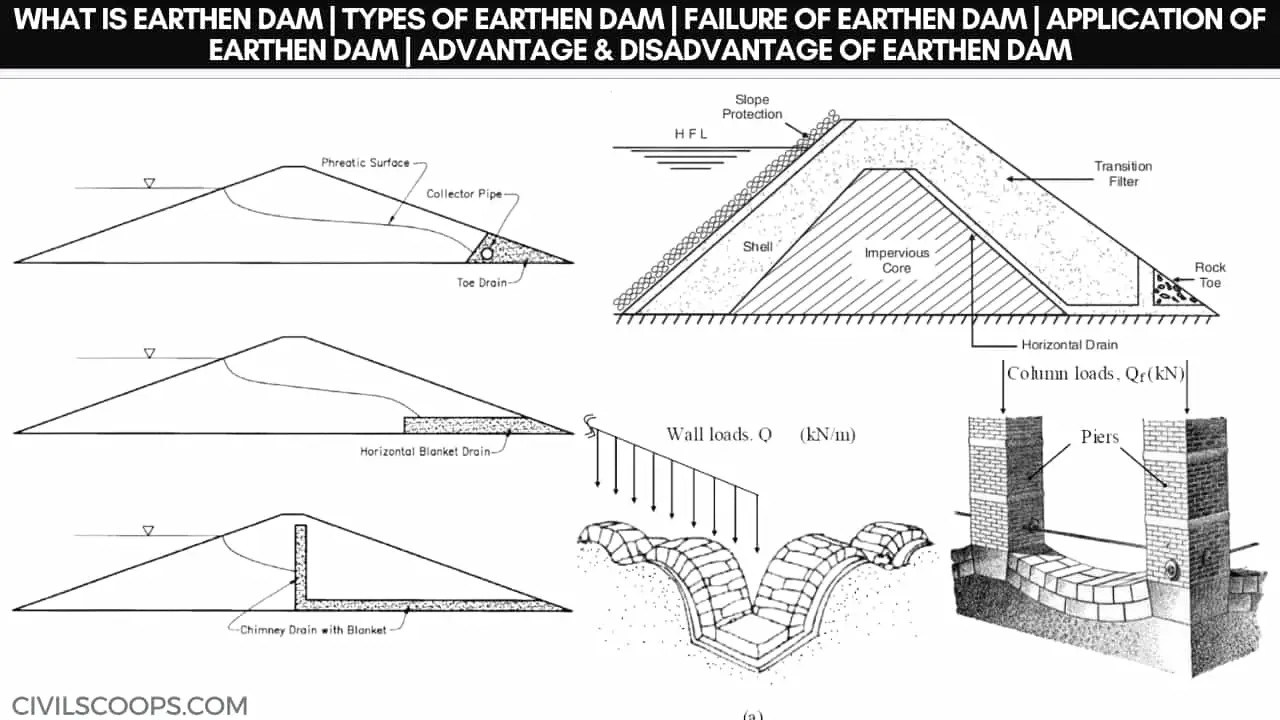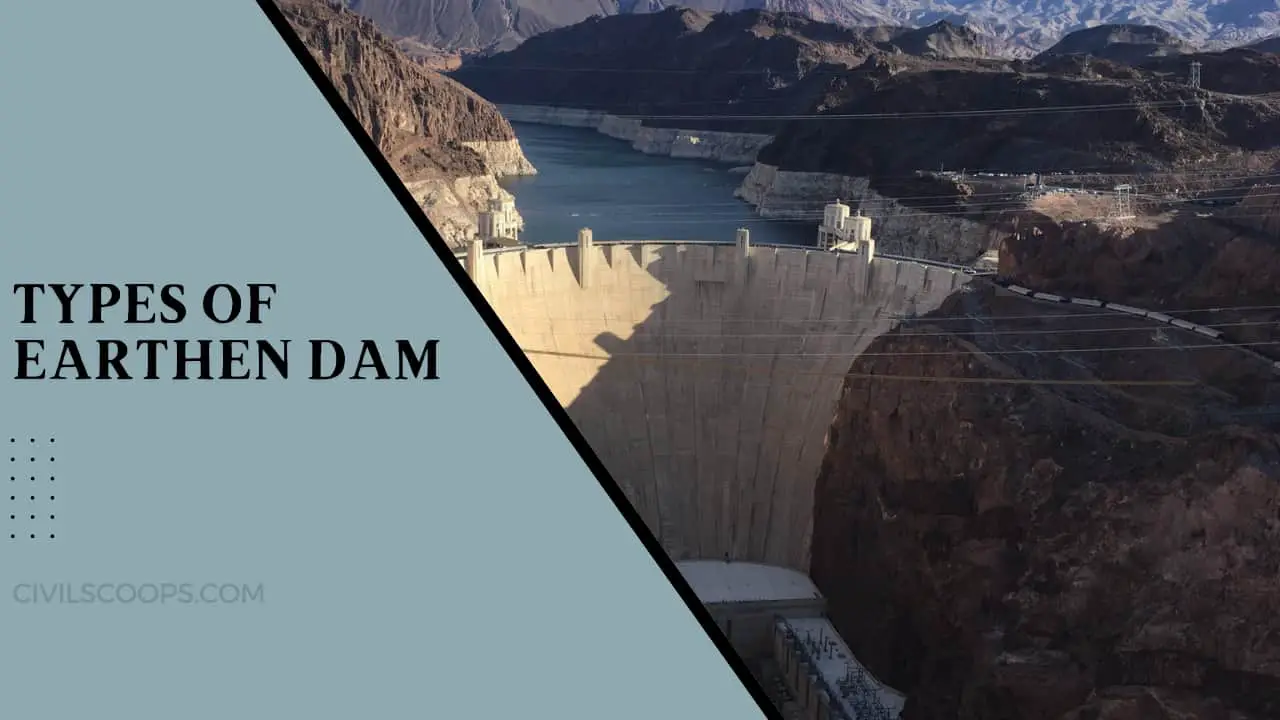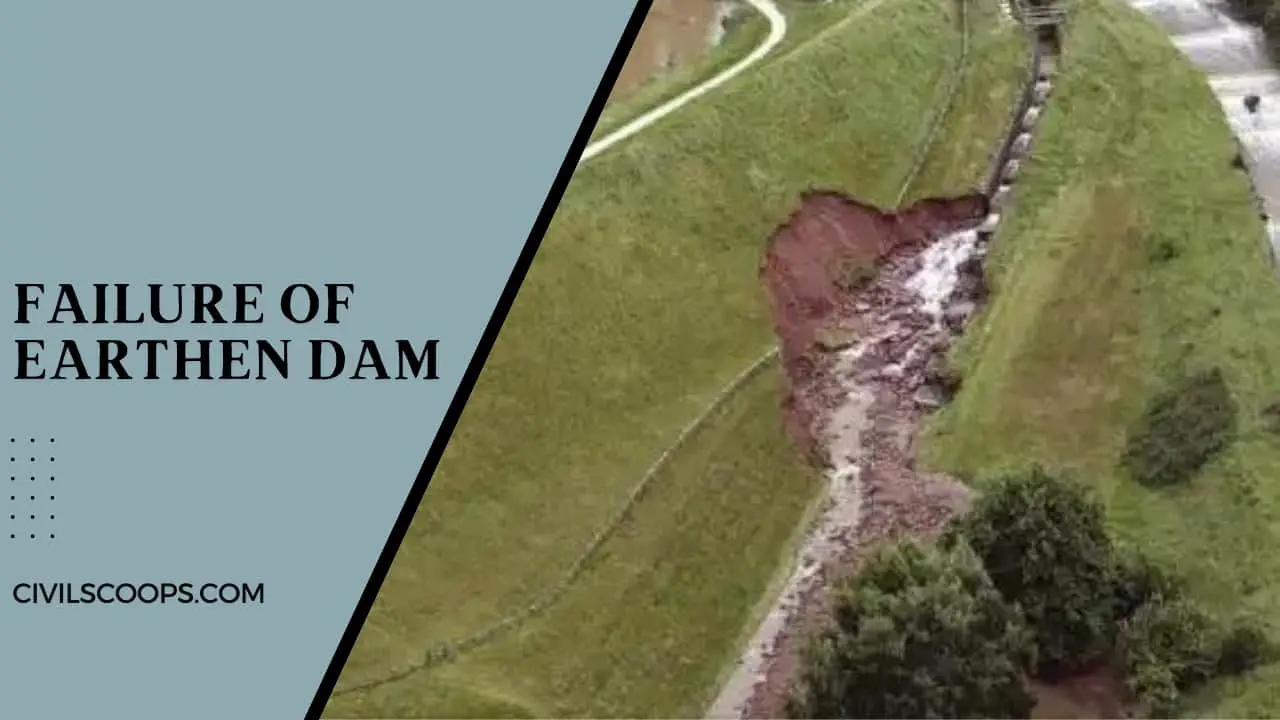What Is Earthen Dam | Types of Earthen Dam | Failure of Earthen Dam | Application of Earthen Dam | Advantage & Disadvantage of Earthen Dam

Table of Contents
What Is Earthen Dam?
The dam which is constructed fulfilled by the earth is known as the earthen dam. The earthen dam is constructed by different layers of soil. The layers of the soil of the earthen dam are then compacted by sheep’s foot rollers, tamping rollers, heavy pneumatic tired rollers, earth-hauling equipment, or vibratory rollers.
The earthen dam is constructed as a barrier that resists water or underground streams. These earthen dams are constructed not only for protection from floods, but also provides water for various needs to include human consumption, irrigation, industrial use, navigability, and aquaculture.
The earthen dam is constructed nearly trapezoidal or trapezoidal cross-section. There are many sizes of earthen dams is constructed. But the size of the dams depends on the requirements.
As for the high earthen dam, the height of the dam is greater than 100 m. As for the medium earthen dam, the height of the dam is lies between 50 m to 100 m. And for the small earthen dam, the height of the dam is lower than 50 m.
Types of Earthen Dam

The earthen dam classifying three types that’s are below –
- Homogeneous Embankment Earthen Dam.
- Zone embankment Earthen Dam.
- Diaphragm Earthen Dam.
1. Homogeneous Embankment Type Earthen Dam
This type of earthen dam is very economical and simple. Because the earthen dam consists of a single material. And this type of earthen dam is also throughout homogeneous.
On the upstream face of the earthen dam sometimes, a blanket of moderately watertight material may be placed. In an earthen dam when just one material is economically or locally available then a simply homogeneous section is used.
2. Zone Type Earthen Dam
The zone-type earthen dams are widely constructed. The material used for the zone-type earthen dam is depending upon their availabilities.
If it shrinks and swells too much, may not make the best core with the clay, despite it being highly impervious. Because of this, sometimes the clay is mixed with fine sand or fine gravel to make an impervious layer for the dam.
As the satisfactory central core materials sometimes silts or silty clays may be used. On the outer shell for freely draining the materials, such as coarse sands and gravels are generally used.
Between the outer and inner zone of the earthen dam, transition filters are provided. From one zone to the other, where the abrupt change of permeability on there the transition filters are always provided.
3. Diaphragm Earthen Dam
The diaphragm earthen dam is surrounded by earth or rocks thin impervious core. This impervious core is made of concrete, impervious oils, timber, steel, or any other material.
To prevent seepage through the dam the impervious core act as a barrier. The diaphragm earthen dam is placed either at the upstream face as a layer or the center as a central vertical core.
To avoid excessive under-seepage through the existing previous foundations in the diaphragm embankment must also be tied to the bedrock or very impervious foundation material.
On depending the thickness of the core the diaphragm embankments are differentiated from zoned embankments.
Failure of Earthen Dam

The earthen dam is less rigid so it has more chance of failure. The classification of the earthen dam is below-
- Hydraulic Failures.
- Seepage Failures.
- Structural Failures.
1. Hydraulic Failures
The hydraulic failure occurs for the following reasons.
1.1. By Overtopping
if the spillway gates are not properly operated or if the design flood is underestimated, then the water may overtop the dam.
1.2. Erosion of Upstream Face
sometimes, cause the slip of the upstream slope and try to notch out the soil from the upstream face and may even due to the winds the waves developed near the topwater surface.
1.3. Cracking Due to Frost Action
The soil with dangerous seepage and consequent failure of the dam may cause frost in the upper portion.
2. Seepage Failures
The seepage failure occurs for the following reasons. Ordinarily, it does not produce any harm by the Controlled seepage, or limited uniform seepage is inevitable in all earth dams.
The subsequent failure of the dams uncontrolled or concentrated seepage through the dam body or its foundation may lead to piping or coughing.
3. Structural Failures
Causing slides Structural failures are generally caused by shear failures. Structural failure occurs for the following reasons. The entire dam may slide over the foundation when the foundation of the earth dams are made of, such as fine silt, soft clay, soft soils, etc.
Methods of Construction of Earth Dam
Here, the methods of construction of earth dam are as follows.
- The method of an earthen dam constructed fulfilled by the earth is known as the earthen dam.
- The earthen dam is constructed by different layers of soil.
- The layers of the soil of the earthen dam are then compacted by sheep’s foot rollers, tamping rollers, heavy pneumatic tired rollers, earth-hauling equipment, or vibratory rollers.
- The earthen dam is constructed as a barrier that resists water or underground streams.
- These earthen dams are constructed not only for protection from floods, but also provides water for various needs to include human consumption, irrigation, industrial use, navigability, and aquaculture
- The earthen dam is constructed nearly trapezoidal or trapezoidal cross-section.
- There are many sizes of earthen dams is constructed. But the size of the dams depends on the requirements.
- As for the high earthen dam, the height of the dam is greater than 100m.
- As for the medium earthen dam, the height of the dam is lies between 50m to 100m.
- And for the small earthen dam, the height of the dam is lower than 50m.
Application of Earthen Dam

There have been many applications of the earthen dam that are below.
- The earthen dam is constructed to apply as a barrier that resists water or underground streams.
- These earthen dams are constructed not only for protection from floods but also applied to for provide water for various needs including human consumption, irrigation, industrial use, navigability, and aquaculture.
- When we need to make an economic structure, then we need to apply the earthen dam because In an earthen dam just one material is economically or locally available then a simply homogeneous section is applied.
- In the earthen dam, hydropower is applied to generate electricity.
- For structural reasons, earth dams are suited to the sites where a masonry dam cannot be applied.
- The earthen dam is applied to either stop or slow the amount of water in a river.
Advantages of Earthen Dam
Here, the pros of earthen dam are as follows.
- The advantage of the earthen dam is the material of the earthen dam like soil can easily available.
- Another advantage of the earthen dam that’s is can easily handle by the hands.
- For structural reasons, earth dams are suited to the sites where a masonry dam cannot be used.
- Another advantage of the earthen dam is it is a lesser cost than normal masonry walls.
- The advantage of the earthen dam is it can slow or stop the amount of water in a river.
Disadvantages of Earthen Dam
Here, the cons of earthen dam are as follows.
- The disadvantages of the earthen dam are the non-availability of the materials at the dams site.
- Another disadvantage of the earthen dam is as compared to a good concrete dam it has a greater maintenance cost.
- For spillways, the earthen dam is none suitable, this is an important disadvantage of an earthen dam.
- The disadvantages of the earthen dam are it is a none rigid material, so it can destroy easily when more stress develops on the dam.
Uses of Earthen Dam
There have been many uses of the earthen dam that’s are below.
- The earthen dam is constructed to use as a barrier that resists water or underground streams.
- These earthen dams are constructed not only for protection from floods, but also used for provides water for various needs to
include human consumption, irrigation, industrial use, navigability, and aquaculture. - When we need to make an economical structure then we used the earthen dam because In an earthen dam just one material is
economically or locally available then a simply homogeneous section is used. - For structural reasons, earth dams are suited to the sites where a masonry dam cannot be used.
- To either stop or slow the amount of water in a river the earthen dam is used.
- The earthen dam is a good choice for sites with wide valleys.
- In the earthen dam, by using hydropower is often used in conjunction with dams to generate electricity.
Earthen Dam PDF: Click Here
[su_box title=”FAQ” style=”default” box_color=”#333333″ title_color=”#FFFFFF” radius=”3″ class=”” id=””]
Earthen Dam
Earthfill dam, also called earth dam or embankment dam, dam built up by compacting successive layers of earth, using the most impervious materials to form a core and placing more permeable substances on the upstream and downstream sides
Types of Earthen Dam
The earthen dam can be of the following three types: 1. Homogeneous Embankment type 2. Zone embankment type 3. Diaphragm type.
Failure of Earthen Dam
Earthen dams may fail, like other engineering structures, due to improper designs, faulty constructions, lack of maintenance, etc. The water may overtop the dam, if the design flood is underestimated or if the spillway is of insufficient capacity or if the spillway gates are not properly operated.
Methods of Construction of Earth Dam
There are two methods of constructing earthen dams: (1) Hydraulic-fill Method; and (2) Rolled-fill Method.
- Hydraulic-fill Method: In this method of construction, the dam body is constructed by excavating and transporting soils by using water. Pipes called flumes, are laid along the outer edge of the embankment. The soil materials are mixed with water and pumped into these flumes. The slush is discharged through the outlets in the flumes at suitable intervals along their lengths.
- Rolled-fill Method: The embankment is constructed by placing suitable soil materials in thin layers (15 to 30 cm) and compacting them with rollers. The soil is brought to the site from burrow pits and spread by bulldozers, etc. In layers. These layers are thoroughly compacted by rollers of designed weights.
Advantages of Earthen Dam
- Availability of Earth Materials.
- Easy Handling of Earth.
- Foundation Condition.
- Cost of Construction.
Disadvantages of Earthen Dam
- Non-availability of the materials at or near the dam site.
- Greater maintenance cost as compared to a good concrete dam.
- Earthen dams are unsuitable for spillways.
Application of Earthen Dam
The earthen dam is constructed to apply as a barrier that resists water or underground streams. These earthen dams are constructed not only for protection from floods, but also applied to for provides water for various needs to include human consumption, irrigation, industrial use, navigability, and aquaculture.
Uses of Earthen Dam
Earth dikes and dams are gravity structures used to impound water or semi-fluid wastes. Water is impounded for flood control, hydroelectric power production, recreation, domestic storage, and industrial uses, includ- ing waste storage.
[/su_box]
[su_note note_color=”#F2F2F2 ” text_color=”#333333″ radius=”3″ class=”” id=””]
Like this post? Share it with your friends!
Suggested Read –
- How a Building Is Constructed | Components of Building
- Building Layout | How to Building Layout | Construction Layout Techniques
- What Is Gable Roof | History of Gable Roofing | Gable Roof Design | Parts of Gable Roof | Types of Gable Roofs | How Long Can the Roof Last? | Gable Roof Advantages and Disadvantages | Cost of Gable Roof Construction |
- What Is Bituminous Road? | Bituminous Road Construction | Bituminous Road Layers | Bituminous Macadam | Bituminous Road Construction Process | Advantages of Bitumen Road | Disadvantages of Bitumen Road | Application Road
- What Is Super Elevation? | Superelevation Definition | Purpose of Providing Superelevation in Roads | Calculation of Superelevation in Roads | Minimum and Maximum Superelevation in Roads | Method of Providing Superelevation to the Roads
[/su_note]
Originally posted 2022-07-19 13:45:44.
